MAZDA MODEL MAZDASPEED 3 2009 Owners Manual (in English)
Manufacturer: MAZDA, Model Year: 2009, Model line: MODEL MAZDASPEED 3, Model: MAZDA MODEL MAZDASPEED 3 2009Pages: 412, PDF Size: 6.18 MB
Page 141 of 412
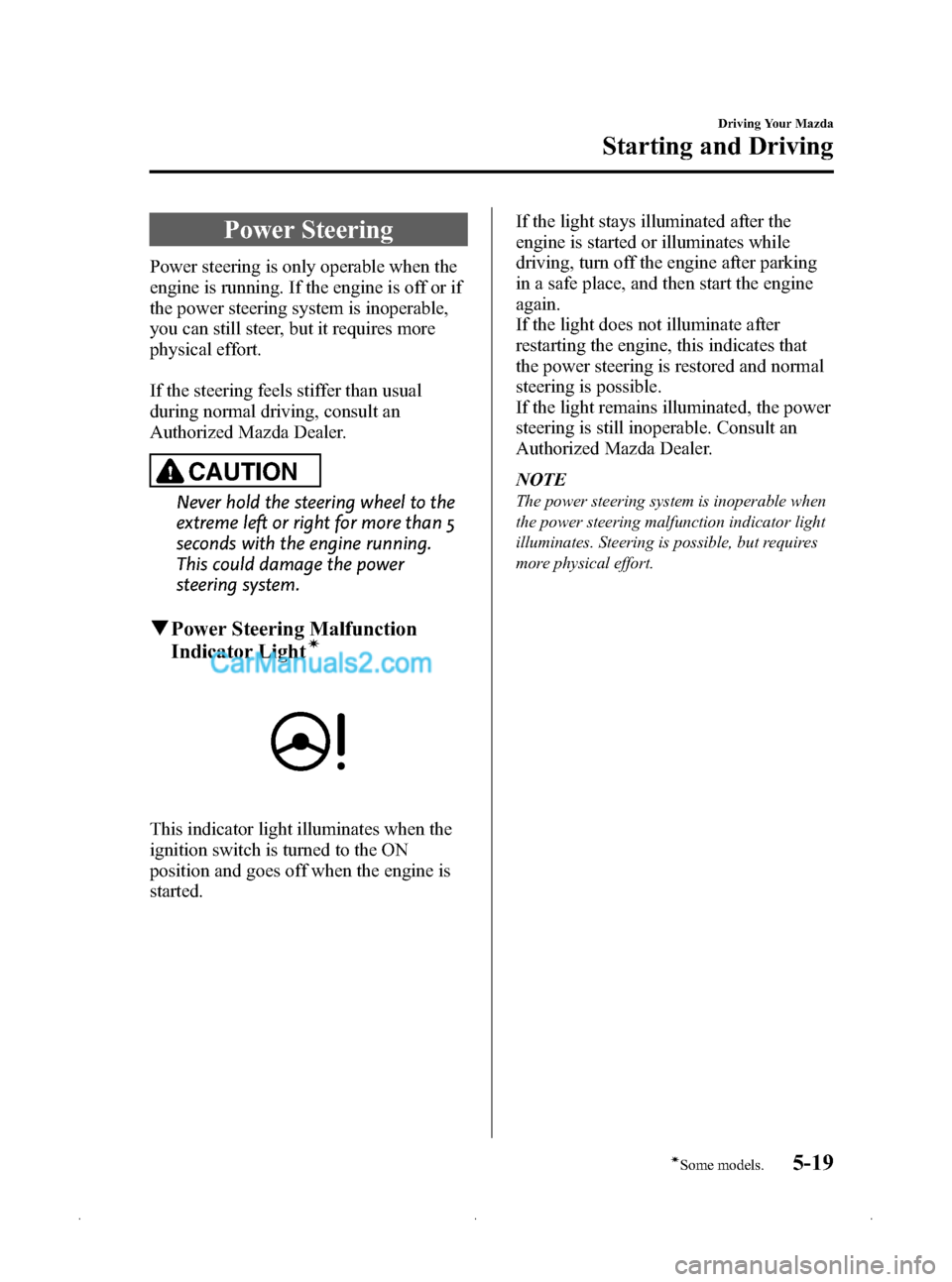
Black plate (141,1)
Power Steering
Power steering is only operable when the
engine is running. If the engine is off or if
the power steering system is inoperable,
you can still steer, but it requires more
physical effort.
If the steering feels stiffer than usual
during normal driving, consult an
Authorized Mazda Dealer.
CAUTION
Never hold the steering wheel to the
extreme left or right for more than 5
seconds with the engine running.
This could damage the power
steering system.
qPower Steering Malfunction
Indicator Lightí
This indicator light illuminates when the
ignition switch is turned to the ON
position and goes off when the engine is
started. If the light stays illuminated after the
engine is started or illuminates while
driving, turn off the engine after parking
in a safe place, and then start the engine
again.
If the light does not illuminate after
restarting the engine, this indicates that
the power steering is restored and normal
steering is possible.
If the light remains illuminated, the power
steering is still inoperable. Consult an
Authorized Mazda Dealer.
NOTE
The power steering system is inoperable when
the power steering malfunction indicator light
illuminates. Steering is possible, but requires
more physical effort.
Driving Your Mazda
Starting and Driving
5-19íSome models.
Mazda3_8Z87-EA-08F_Edition1 Page141
Monday, May 19 2008 9:57 AM
Form No.8Z87-EA-08F
Page 142 of 412
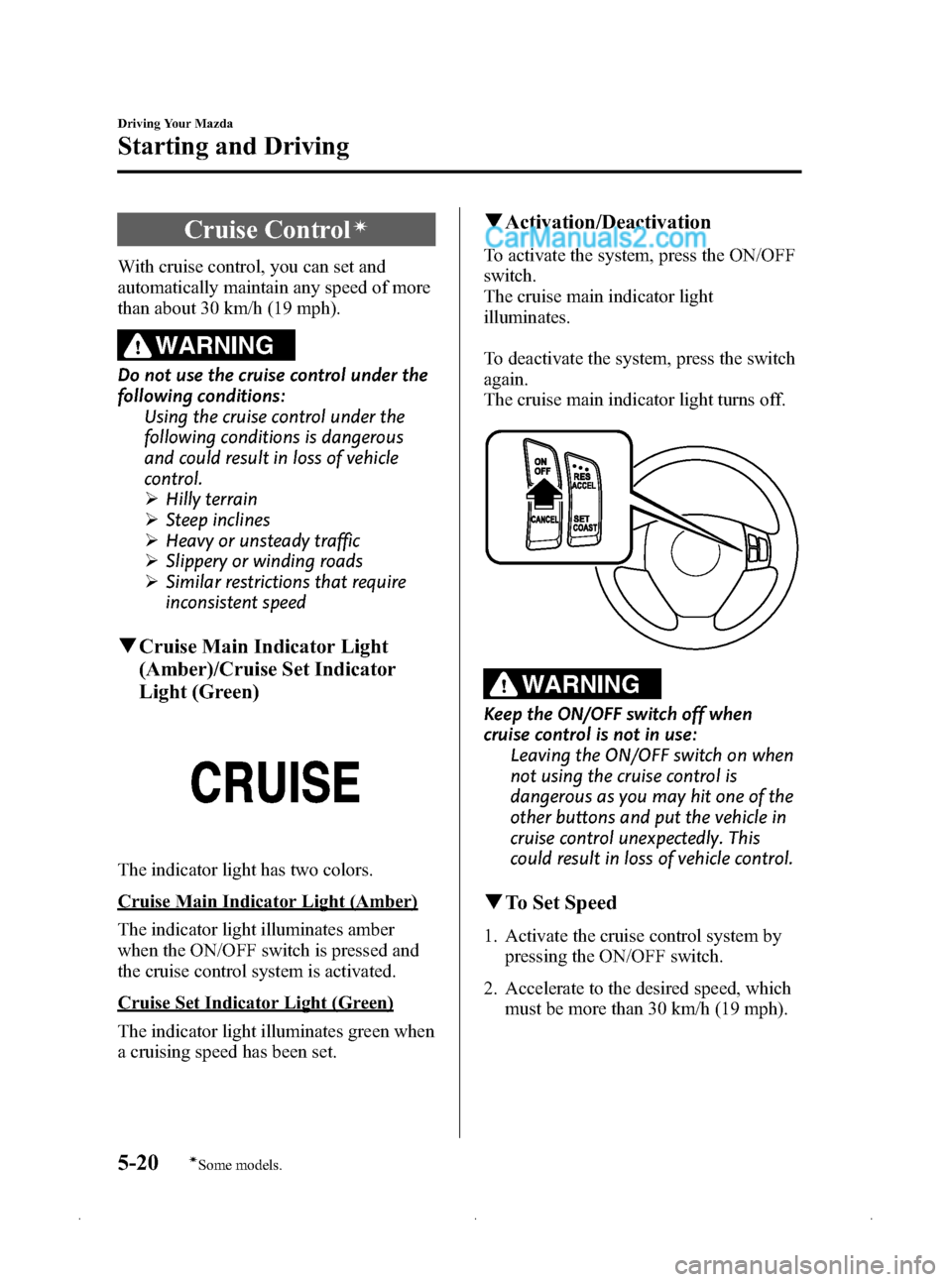
Black plate (142,1)
Cruise Controlí
With cruise control, you can set and
automatically maintain any speed of more
than about 30 km/h (19 mph).
WARNING
Do not use the cruise control under the
following conditions:Using the cruise control under the
following conditions is dangerous
and could result in loss of vehicle
control.
ØHilly terrain
Ø Steep inclines
Ø Heavy or unsteady traffic
Ø Slippery or winding roads
Ø Similar restrictions that require
inconsistent speed
qCruise Main Indicator Light
(Amber)/Cruise Set Indicator
Light (Green)
The indicator light has two colors.
Cruise Main Indicator Light (Amber)
The indicator light illuminates amber
when the ON/OFF switch is pressed and
the cruise control system is activated.
Cruise Set Indicator Light (Green)
The indicator light illuminates green when
a cruising speed has been set.
qActivation/Deactivation
To activate the system, press the ON/OFF
switch.
The cruise main indicator light
illuminates.
To deactivate the system, press the switch
again.
The cruise main indicator light turns off.
WARNING
Keep the ON/OFF switch off when
cruise control is not in use:
Leaving the ON/OFF switch on when
not using the cruise control is
dangerous as you may hit one of the
other buttons and put the vehicle in
cruise control unexpectedly. This
could result in loss of vehicle control.
qTo Set Speed
1. Activate the cruise control system by
pressing the ON/OFF switch.
2. Accelerate to the desired speed, which must be more than 30 km/h (19 mph).
5-20
Driving Your Mazda
íSome models.
Starting and Driving
Mazda3_8Z87-EA-08F_Edition1 Page142
Monday, May 19 2008 9:57 AM
Form No.8Z87-EA-08F
Page 143 of 412
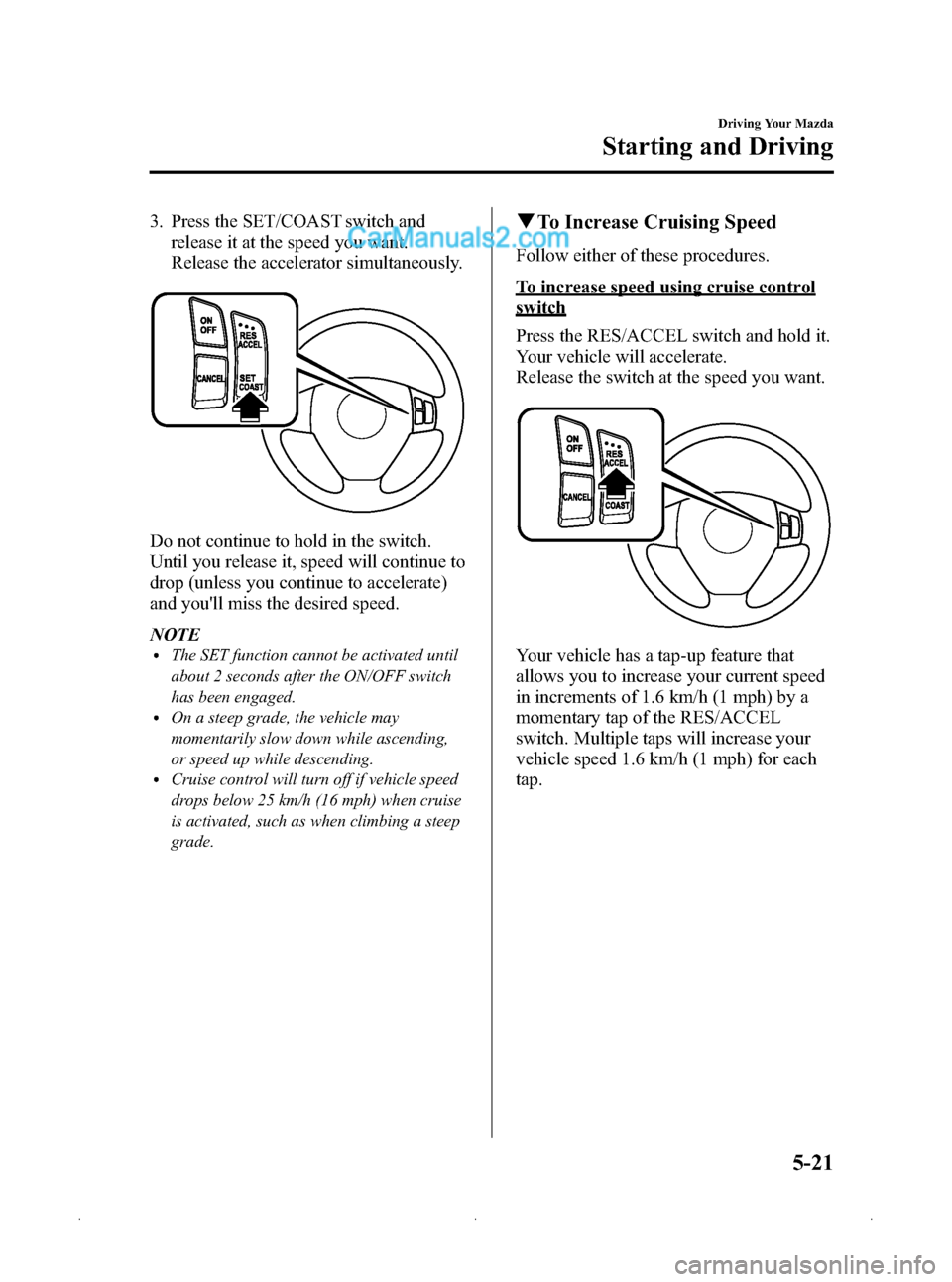
Black plate (143,1)
3. Press the SET/COAST switch andrelease it at the speed you want.
Release the accelerator simultaneously.
Do not continue to hold in the switch.
Until you release it, speed will continue to
drop (unless you continue to accelerate)
and you'll miss the desired speed.
NOTE
lThe SET function cannot be activated until
about 2 seconds after the ON/OFF switch
has been engaged.
lOn a steep grade, the vehicle may
momentarily slow down while ascending,
or speed up while descending.
lCruise control will turn off if vehicle speed
drops below 25 km/h (16 mph) when cruise
is activated, such as when climbing a steep
grade.
qTo Increase Cruising Speed
Follow either of these procedures.
To increase speed using cruise control
switch
Press the RES/ACCEL switch and hold it.
Your vehicle will accelerate.
Release the switch at the speed you want.
Your vehicle has a tap-up feature that
allows you to increase your current speed
in increments of 1.6 km/h (1 mph) by a
momentary tap of the RES/ACCEL
switch. Multiple taps will increase your
vehicle speed 1.6 km/h (1 mph) for each
tap.
Driving Your Mazda
Starting and Driving
5-21
Mazda3_8Z87-EA-08F_Edition1 Page143
Monday, May 19 2008 9:57 AM
Form No.8Z87-EA-08F
Page 144 of 412
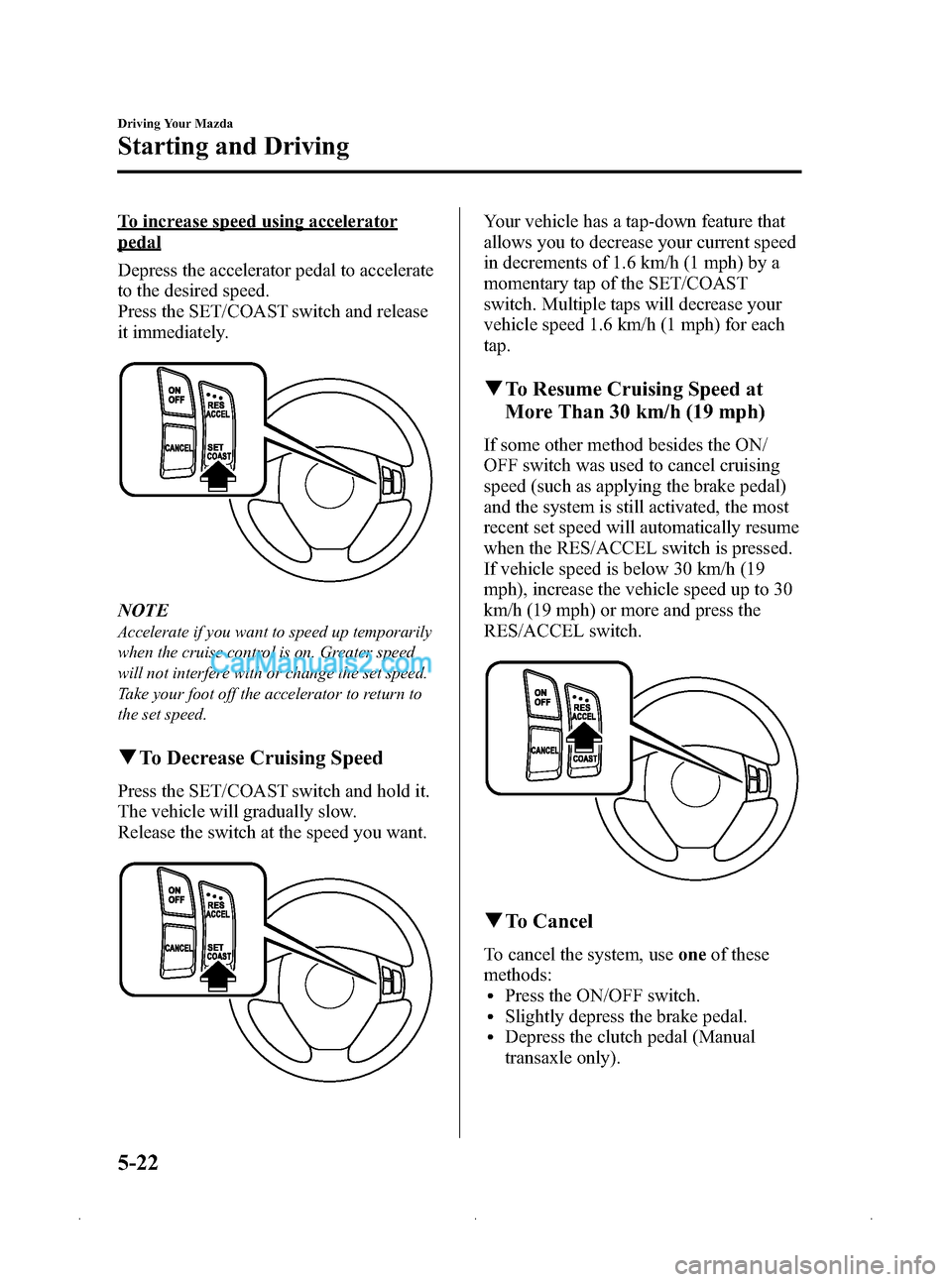
Black plate (144,1)
To increase speed using accelerator
pedal
Depress the accelerator pedal to accelerate
to the desired speed.
Press the SET/COAST switch and release
it immediately.
NOTE
Accelerate if you want to speed up temporarily
when the cruise control is on. Greater speed
will not interfere with or change the set speed.
Take your foot off the accelerator to return to
the set speed.
qTo Decrease Cruising Speed
Press the SET/COAST switch and hold it.
The vehicle will gradually slow.
Release the switch at the speed you want.
Your vehicle has a tap-down feature that
allows you to decrease your current speed
in decrements of 1.6 km/h (1 mph) by a
momentary tap of the SET/COAST
switch. Multiple taps will decrease your
vehicle speed 1.6 km/h (1 mph) for each
tap.
qTo Resume Cruising Speed at
More Than 30 km/h (19 mph)
If some other method besides the ON/
OFF switch was used to cancel cruising
speed (such as applying the brake pedal)
and the system is still activated, the most
recent set speed will automatically resume
when the RES/ACCEL switch is pressed.
If vehicle speed is below 30 km/h (19
mph), increase the vehicle speed up to 30
km/h (19 mph) or more and press the
RES/ACCEL switch.
qTo Cancel
To cancel the system, use oneof these
methods:
lPress the ON/OFF switch.lSlightly depress the brake pedal.lDepress the clutch pedal (Manual
transaxle only).
5-22
Driving Your Mazda
Starting and Driving
Mazda3_8Z87-EA-08F_Edition1 Page144
Monday, May 19 2008 9:57 AM
Form No.8Z87-EA-08F
Page 145 of 412
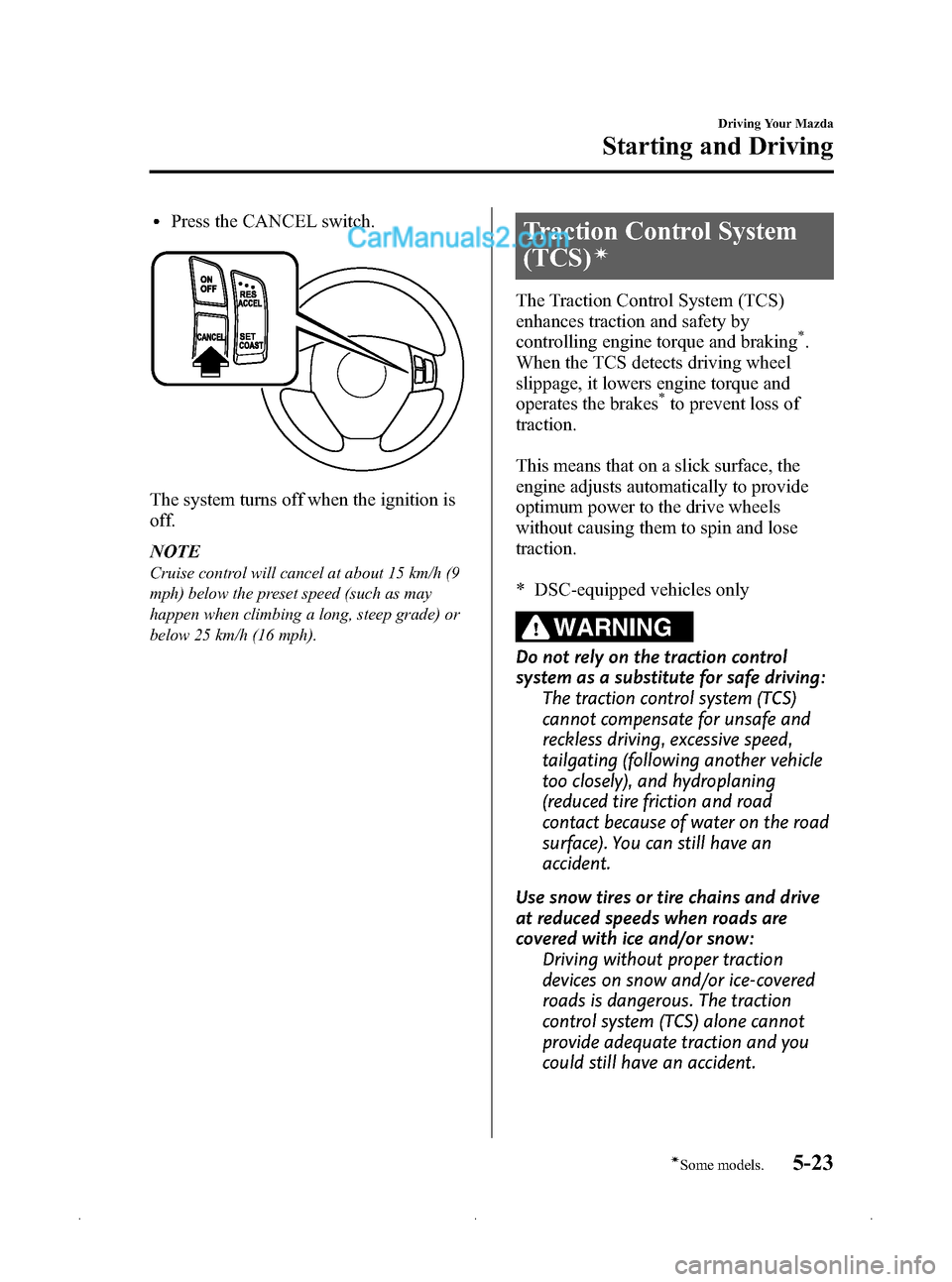
Black plate (145,1)
lPress the CANCEL switch.
The system turns off when the ignition is
off.
NOTE
Cruise control will cancel at about 15 km/h (9
mph) below the preset speed (such as may
happen when climbing a long, steep grade) or
below 25 km/h (16 mph).
Traction Control System
(TCS)
í
The Traction Control System (TCS)
enhances traction and safety by
controlling engine torque and braking
*.
When the TCS detects driving wheel
slippage, it lowers engine torque and
operates the brakes
*to prevent loss of
traction.
This means that on a slick surface, the
engine adjusts automatically to provide
optimum power to the drive wheels
without causing them to spin and lose
traction.
* DSC-equipped vehicles only
WARNING
Do not rely on the traction control
system as a substitute for safe driving: The traction control system (TCS)
cannot compensate for unsafe and
reckless driving, excessive speed,
tailgating (following another vehicle
too closely), and hydroplaning
(reduced tire friction and road
contact because of water on the road
surface). You can still have an
accident.
Use snow tires or tire chains and drive
at reduced speeds when roads are
covered with ice and/or snow: Driving without proper traction
devices on snow and/or ice-covered
roads is dangerous. The traction
control system (TCS) alone cannot
provide adequate traction and you
could still have an accident.
Driving Your Mazda
Starting and Driving
5-23íSome models.
Mazda3_8Z87-EA-08F_Edition1 Page145
Monday, May 19 2008 9:57 AM
Form No.8Z87-EA-08F
Page 146 of 412
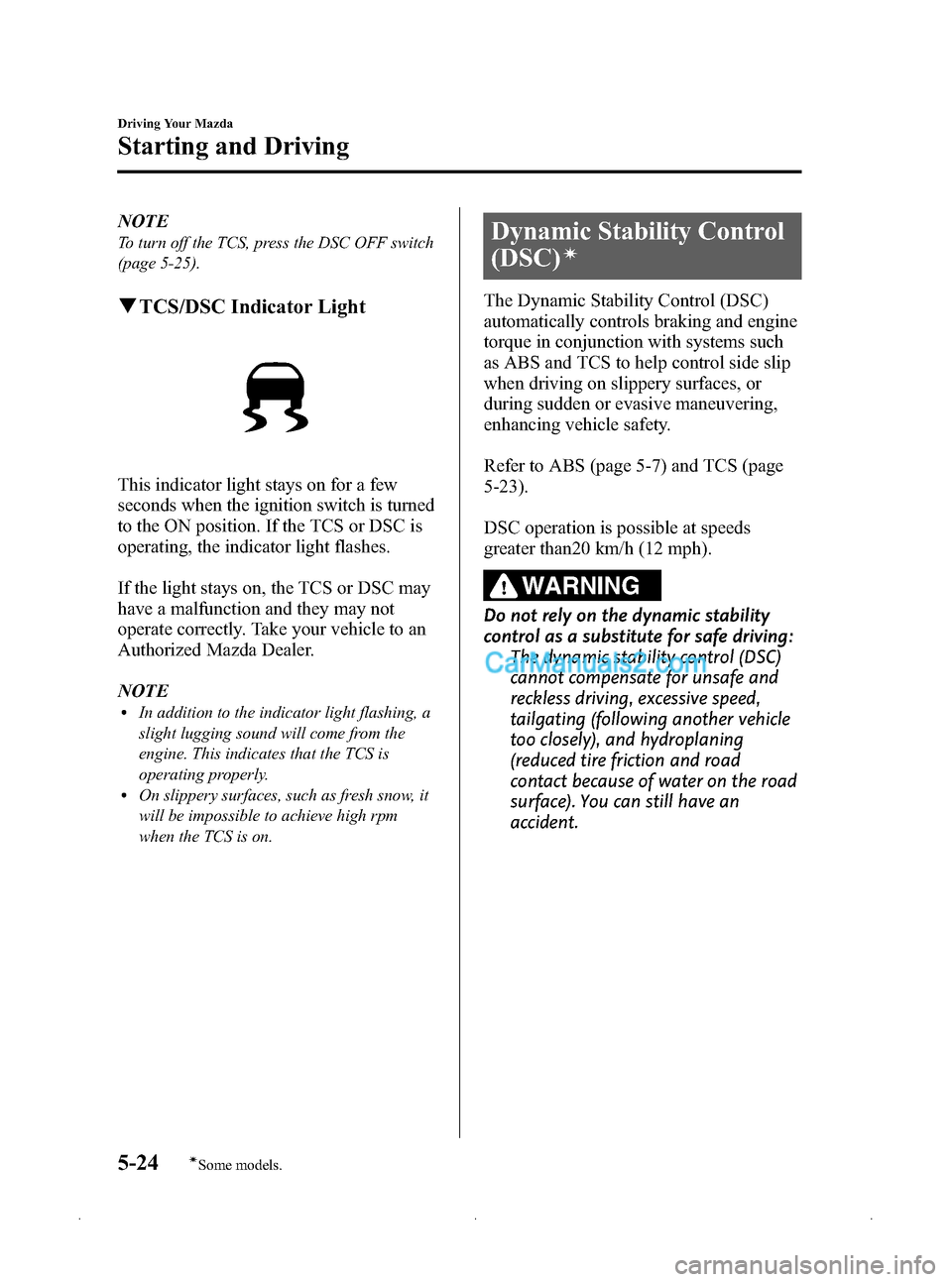
Black plate (146,1)
NOTE
To turn off the TCS, press the DSC OFF switch
(page 5-25).
qTCS/DSC Indicator Light
This indicator light stays on for a few
seconds when the ignition switch is turned
to the ON position. If the TCS or DSC is
operating, the indicator light flashes.
If the light stays on, the TCS or DSC may
have a malfunction and they may not
operate correctly. Take your vehicle to an
Authorized Mazda Dealer.
NOTE
lIn addition to the indicator light flashing, a
slight lugging sound will come from the
engine. This indicates that the TCS is
operating properly.
lOn slippery surfaces, such as fresh snow, it
will be impossible to achieve high rpm
when the TCS is on.
Dynamic Stability Control
(DSC)
í
The Dynamic Stability Control (DSC)
automatically controls braking and engine
torque in conjunction with systems such
as ABS and TCS to help control side slip
when driving on slippery surfaces, or
during sudden or evasive maneuvering,
enhancing vehicle safety.
Refer to ABS (page 5-7) and TCS (page
5-23).
DSC operation is possible at speeds
greater than20 km/h (12 mph).
WARNING
Do not rely on the dynamic stability
control as a substitute for safe driving:
The dynamic stability control (DSC)
cannot compensate for unsafe and
reckless driving, excessive speed,
tailgating (following another vehicle
too closely), and hydroplaning
(reduced tire friction and road
contact because of water on the road
surface). You can still have an
accident.
5-24
Driving Your Mazda
íSome models.
Starting and Driving
Mazda3_8Z87-EA-08F_Edition1 Page146
Monday, May 19 2008 9:57 AM
Form No.8Z87-EA-08F
Page 147 of 412
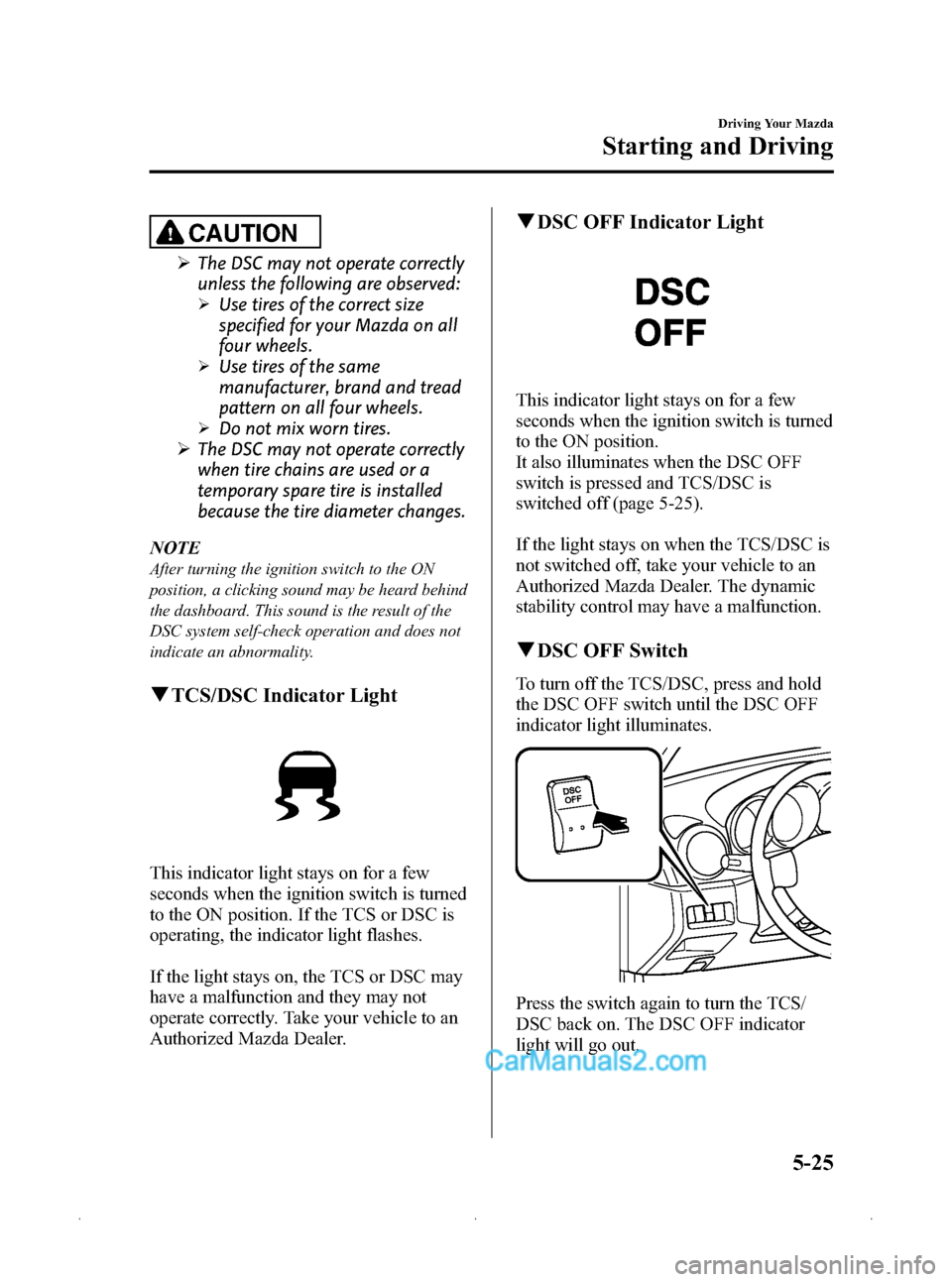
Black plate (147,1)
CAUTION
ØThe DSC may not operate correctly
unless the following are observed:
ØUse tires of the correct size
specified for your Mazda on all
four wheels.
ØUse tires of the same
manufacturer, brand and tread
pattern on all four wheels.
ØDo not mix worn tires.
Ø The DSC may not operate correctly
when tire chains are used or a
temporary spare tire is installed
because the tire diameter changes.
NOTE
After turning the ignition switch to the ON
position, a clicking sound may be heard behind
the dashboard. This sound is the result of the
DSC system self-check operation and does not
indicate an abnormality.
q TCS/DSC Indicator Light
This indicator light stays on for a few
seconds when the ignition switch is turned
to the ON position. If the TCS or DSC is
operating, the indicator light flashes.
If the light stays on, the TCS or DSC may
have a malfunction and they may not
operate correctly. Take your vehicle to an
Authorized Mazda Dealer.
qDSC OFF Indicator Light
This indicator light stays on for a few
seconds when the ignition switch is turned
to the ON position.
It also illuminates when the DSC OFF
switch is pressed and TCS/DSC is
switched off (page 5-25).
If the light stays on when the TCS/DSC is
not switched off, take your vehicle to an
Authorized Mazda Dealer. The dynamic
stability control may have a malfunction.
qDSC OFF Switch
To turn off the TCS/DSC, press and hold
the DSC OFF switch until the DSC OFF
indicator light illuminates.
Press the switch again to turn the TCS/
DSC back on. The DSC OFF indicator
light will go out.
Driving Your Mazda
Starting and Driving
5-25
Mazda3_8Z87-EA-08F_Edition1 Page147
Monday, May 19 2008 9:57 AM
Form No.8Z87-EA-08F
Page 148 of 412
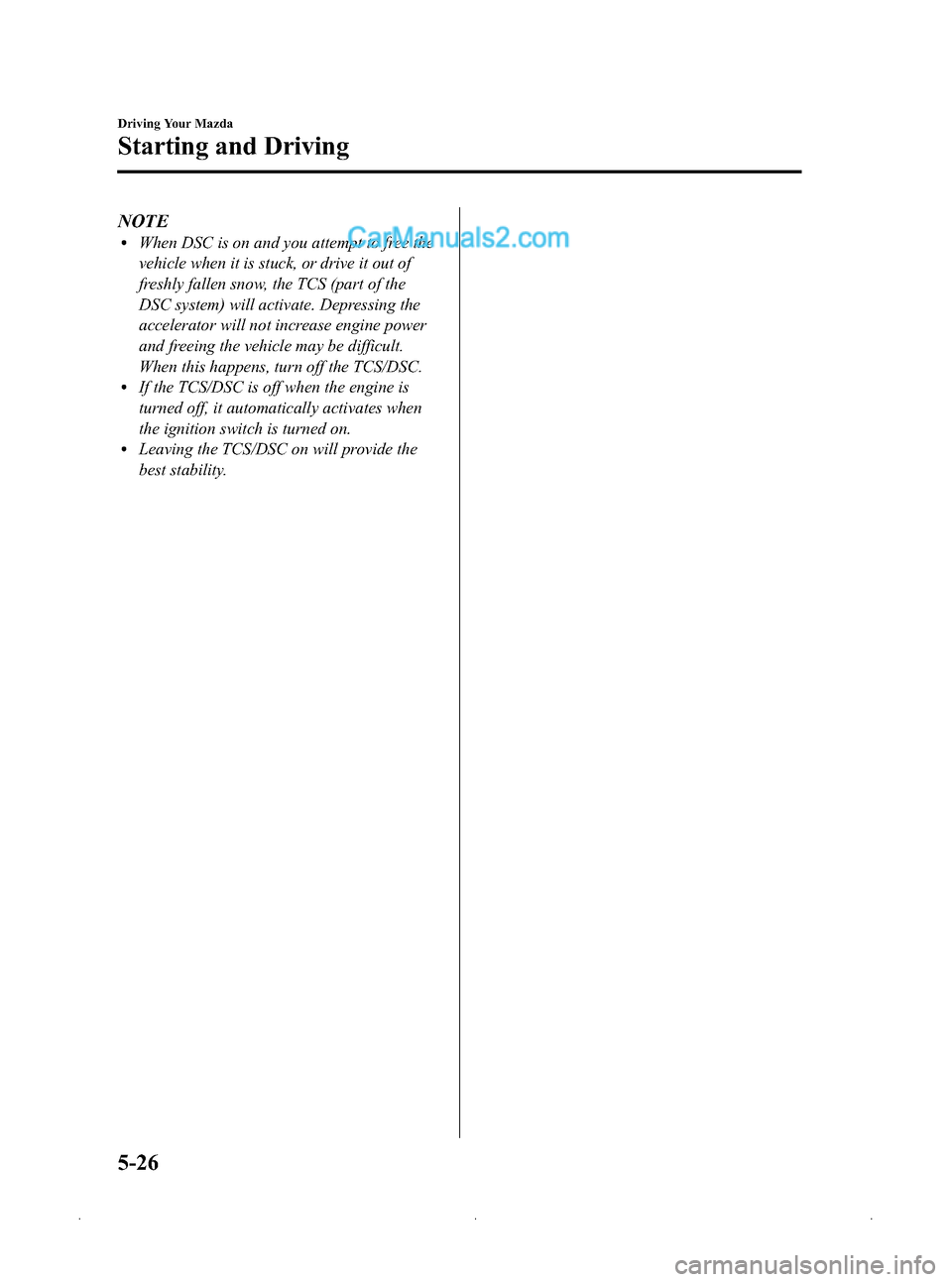
Black plate (148,1)
NOTElWhen DSC is on and you attempt to free the
vehicle when it is stuck, or drive it out of
freshly fallen snow, the TCS (part of the
DSC system) will activate. Depressing the
accelerator will not increase engine power
and freeing the vehicle may be difficult.
When this happens, turn off the TCS/DSC.
lIf the TCS/DSC is off when the engine is
turned off, it automatically activates when
the ignition switch is turned on.
lLeaving the TCS/DSC on will provide the
best stability.
5-26
Driving Your Mazda
Starting and Driving
Mazda3_8Z87-EA-08F_Edition1 Page148
Monday, May 19 2008 9:57 AM
Form No.8Z87-EA-08F
Page 149 of 412
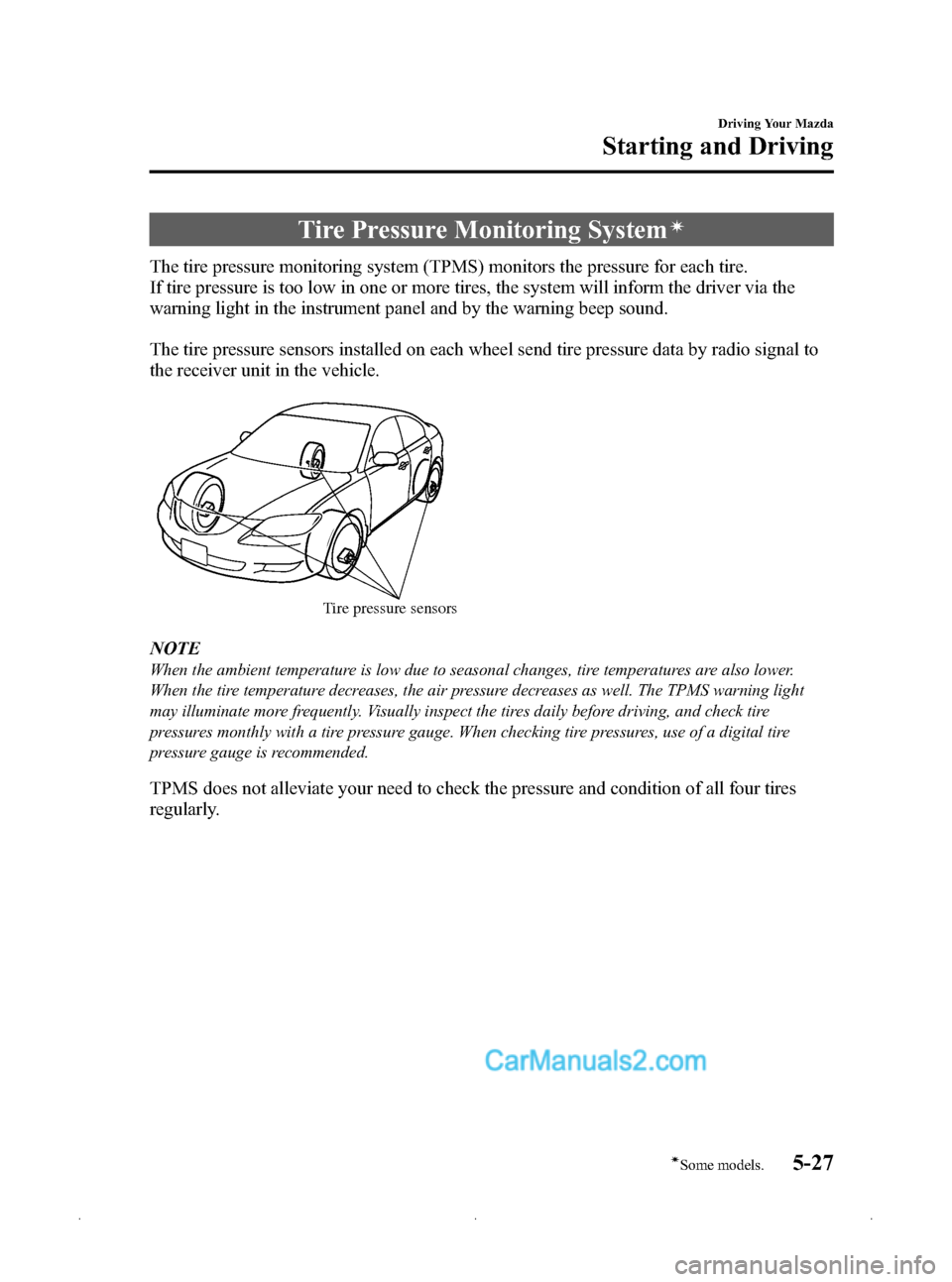
Black plate (149,1)
Tire Pressure Monitoring Systemí
The tire pressure monitoring system (TPMS) monitors the pressure for each tire.
If tire pressure is too low in one or more tires, the system will inform the driver via the
warning light in the instrument panel and by the warning beep sound.
The tire pressure sensors installed on each wheel send tire pressure data by radio signal to
the receiver unit in the vehicle.
Tire pressure sensors
NOTE
When the ambient temperature is low due to seasonal changes, tire temperatures are also lower.
When the tire temperature decreases, the air pressure decreases as well. The TPMS warning light
may illuminate more frequently. Visually inspect the tires daily before driving, and check tire
pressures monthly with a tire pressure gauge. When checking tire pressures, use of a digital tire
pressure gauge is recommended.
TPMS does not alleviate your need to check the pressure and condition of all four tires
regularly.
Driving Your Mazda
Starting and Driving
5-27íSome models.
Mazda3_8Z87-EA-08F_Edition1 Page149
Monday, May 19 2008 9:57 AM
Form No.8Z87-EA-08F
Page 150 of 412
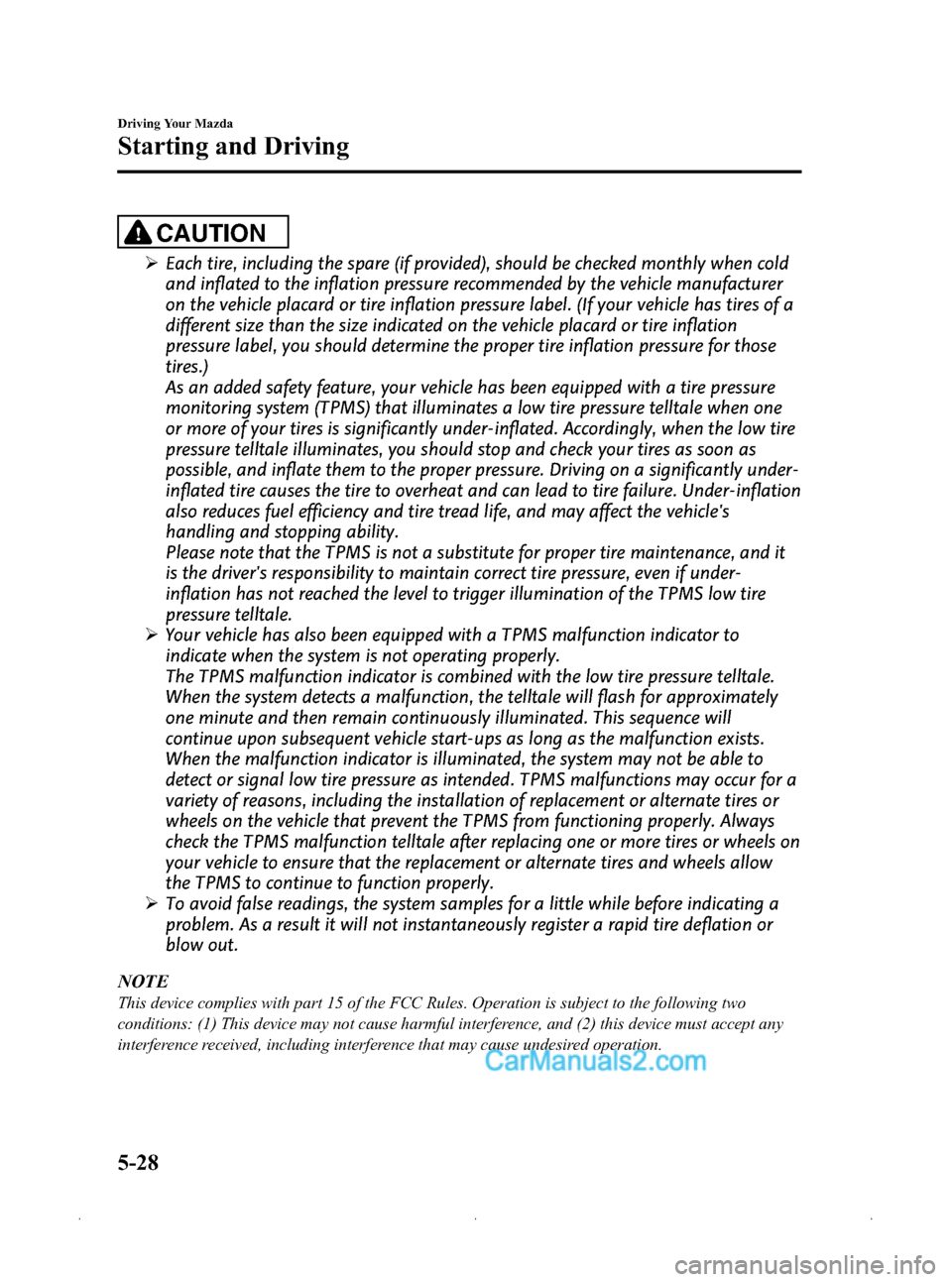
Black plate (150,1)
CAUTION
ØEach tire, including the spare (if provided), should be checked monthly when cold
and inflated to the inflation pressure recommended by the vehicle manufacturer
on the vehicle placard or tire inflation pressure label. (If your vehicle has tires of a
different size than the size indicated on the vehicle placard or tire inflation
pressure label, you should determine the proper tire inflation pressure for those
tires.)
As an added safety feature, your vehicle has been equipped with a tire pressure
monitoring system (TPMS) that illuminates a low tire pressure telltale when one
or more of your tires is significantly under-inflated. Accordingly, when the low tire
pressure telltale illuminates, you should stop and check your tires as soon as
possible, and inflate them to the proper pressure. Driving on a significantly under-
inflated tire causes the tire to overheat and can lead to tire failure. Under-inflation
also reduces fuel efficiency and tire tread life, and may affect the vehicle's
handling and stopping ability.
Please note that the TPMS is not a substitute for proper tire maintenance, and it
is the driver's responsibility to maintain correct tire pressure, even if under-
inflation has not reached the level to trigger illumination of the TPMS low tire
pressure telltale.
Ø Your vehicle has also been equipped with a TPMS malfunction indicator to
indicate when the system is not operating properly.
The TPMS malfunction indicator is combined with the low tire pressure telltale.
When the system detects a malfunction, the telltale will flash for approximately
one minute and then remain continuously illuminated. This sequence will
continue upon subsequent vehicle start-ups as long as the malfunction exists.
When the malfunction indicator is illuminated, the system may not be able to
detect or signal low tire pressure as intended. TPMS malfunctions may occur for a
variety of reasons, including the installation of replacement or alternate tires or
wheels on the vehicle that prevent the TPMS from functioning properly. Always
check the TPMS malfunction telltale after replacing one or more tires or wheels on
your vehicle to ensure that the replacement or alternate tires and wheels allow
the TPMS to continue to function properly.
Ø To avoid false readings, the system samples for a little while before indicating a
problem. As a result it will not instantaneously register a rapid tire deflation or
blow out.
NOTE
This device complies with part 15 of the FCC Rules. Operation is subject to the following two
conditions: (1) This device may not cause harmful interference, and (2) this device must accept any
interference received, including interference that may cause undesired operation.
5-28
Driving Your Mazda
Starting and Driving
Mazda3_8Z87-EA-08F_Edition1 Page150
Monday, May 19 2008 9:57 AM
Form No.8Z87-EA-08F